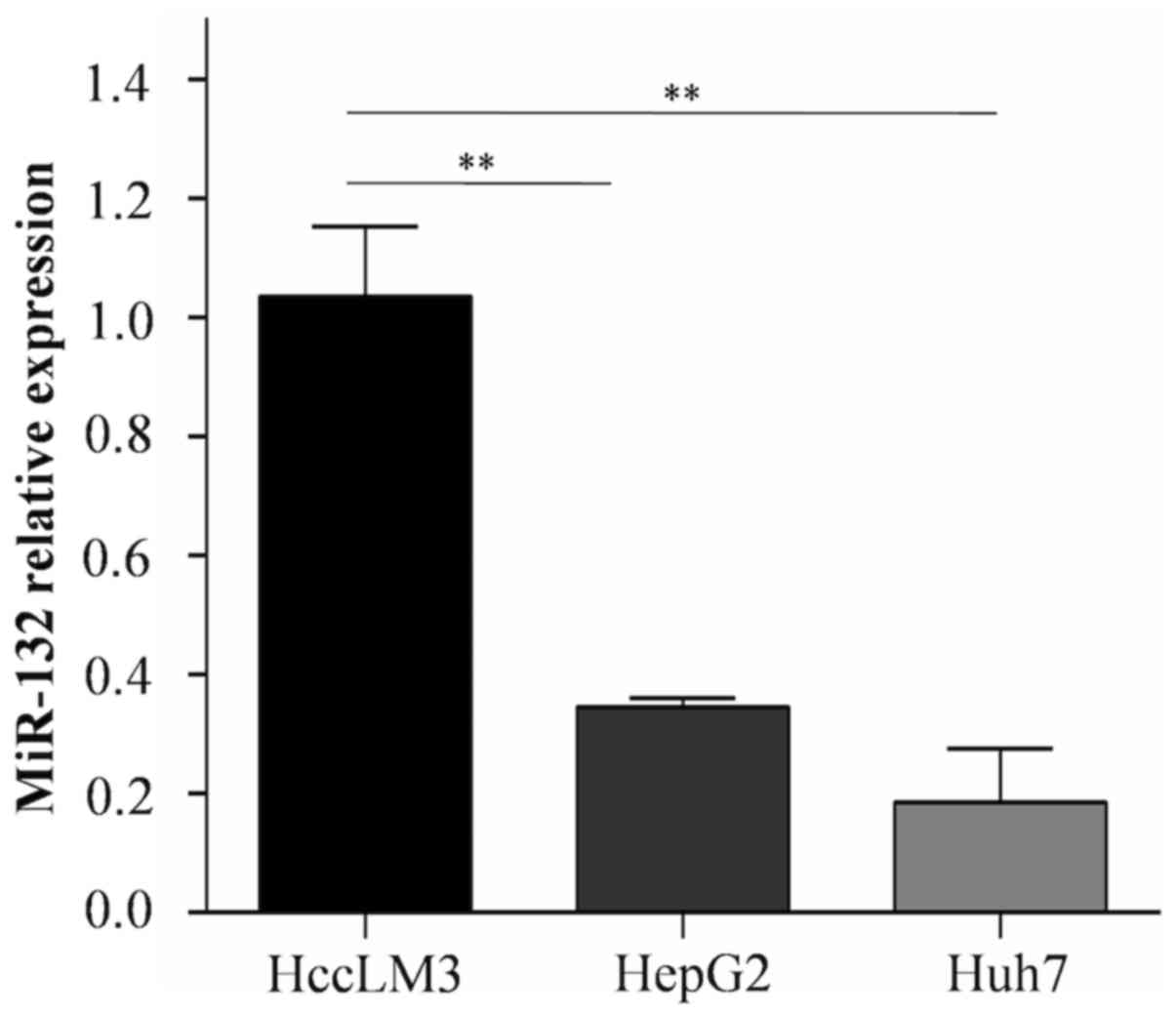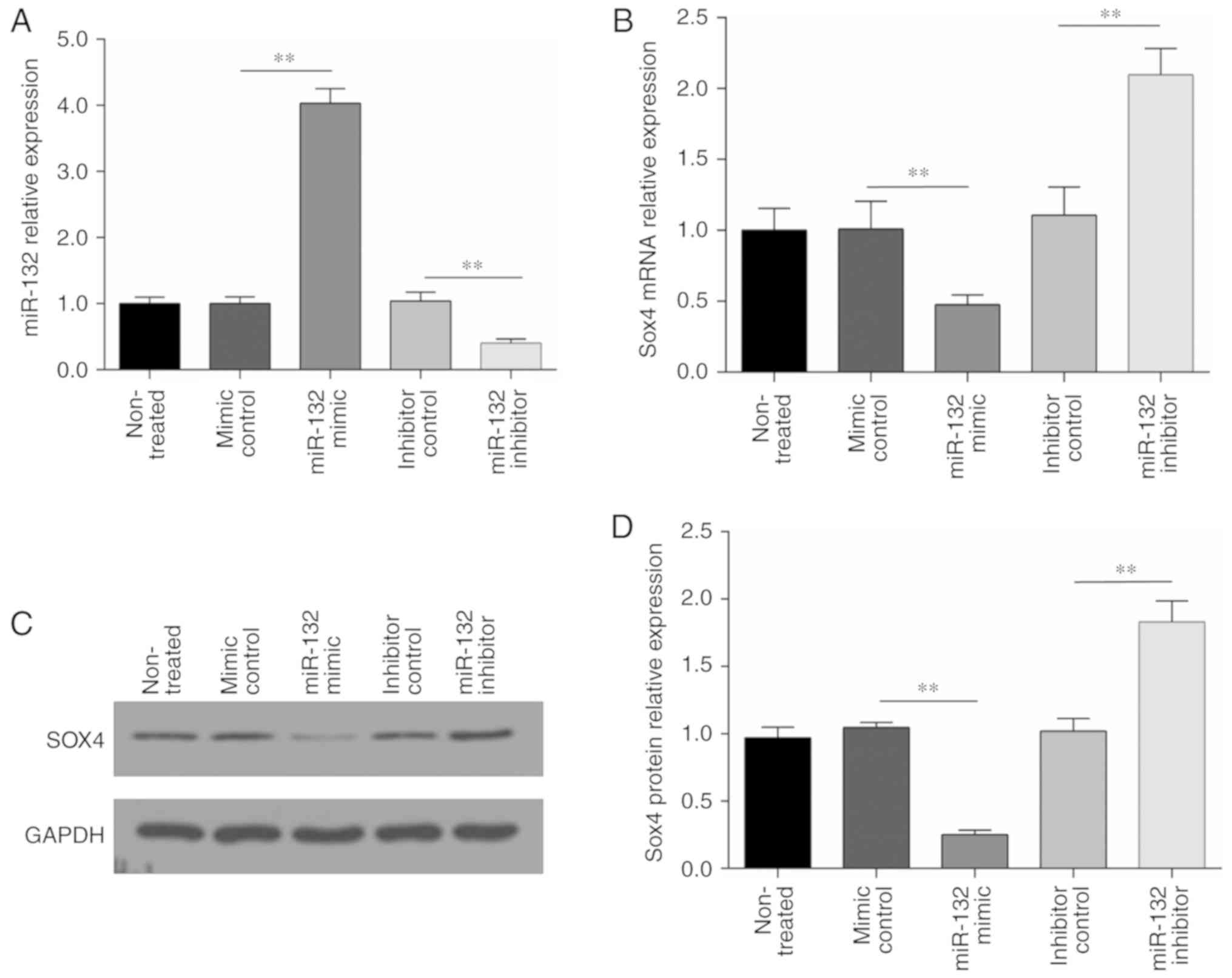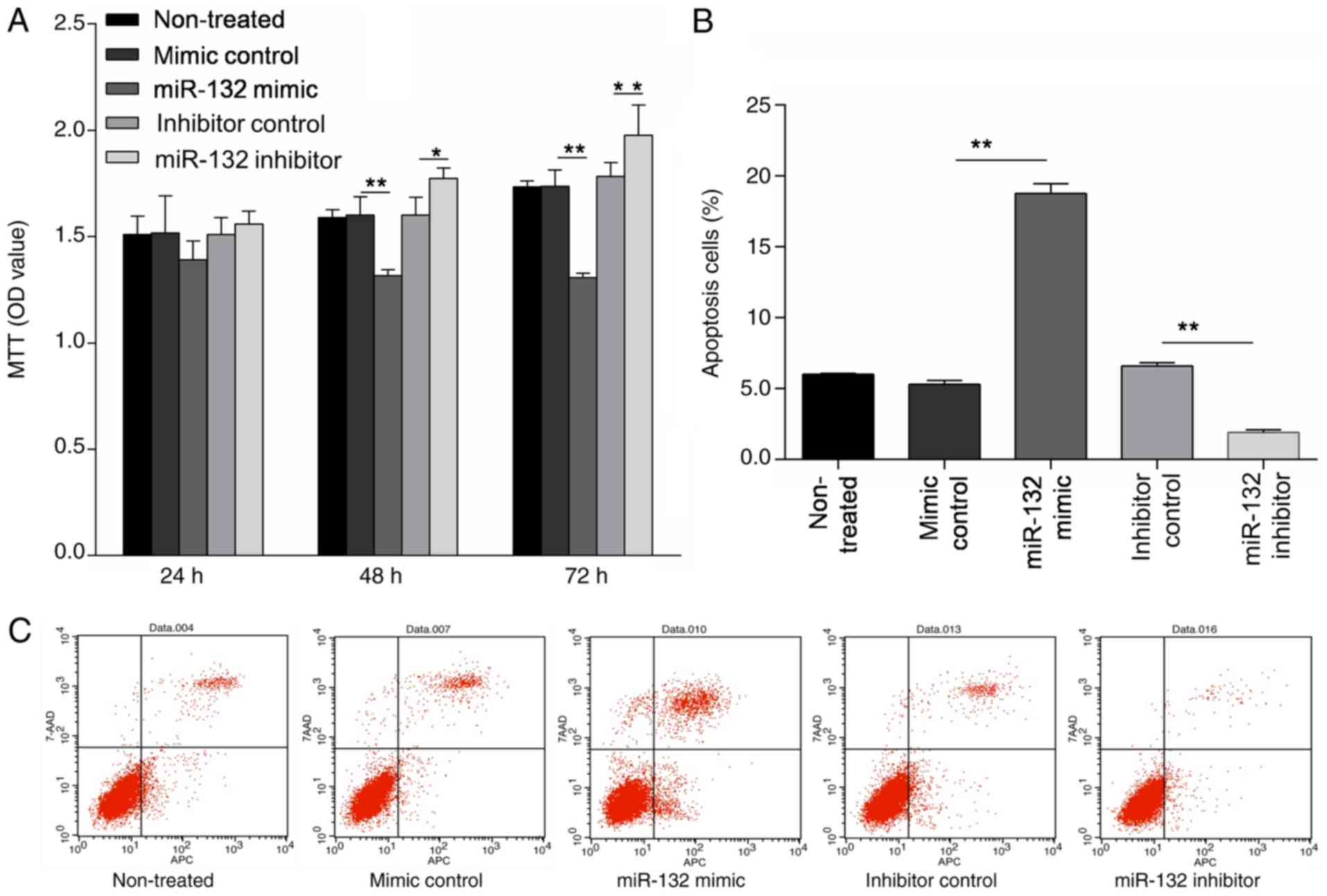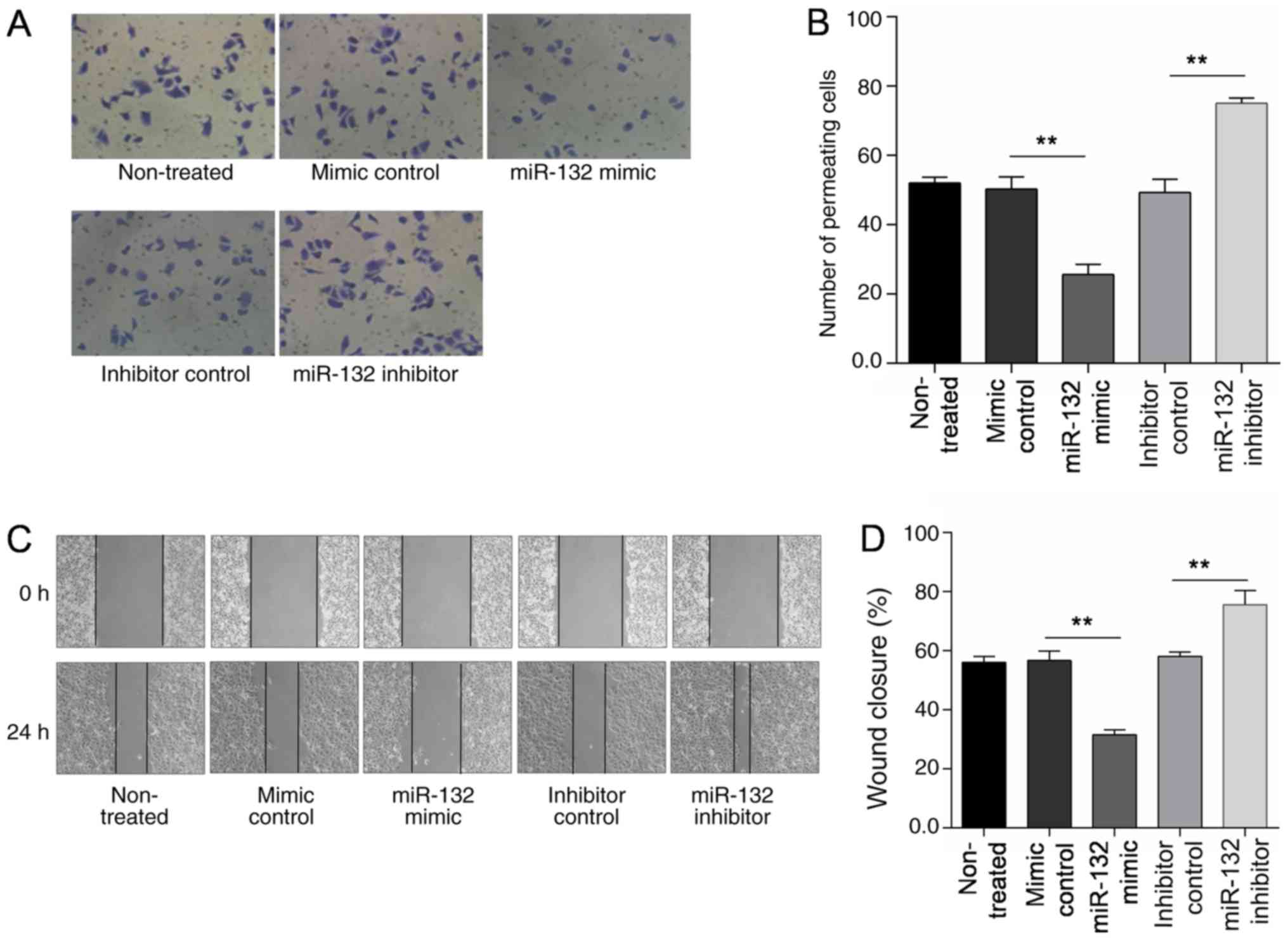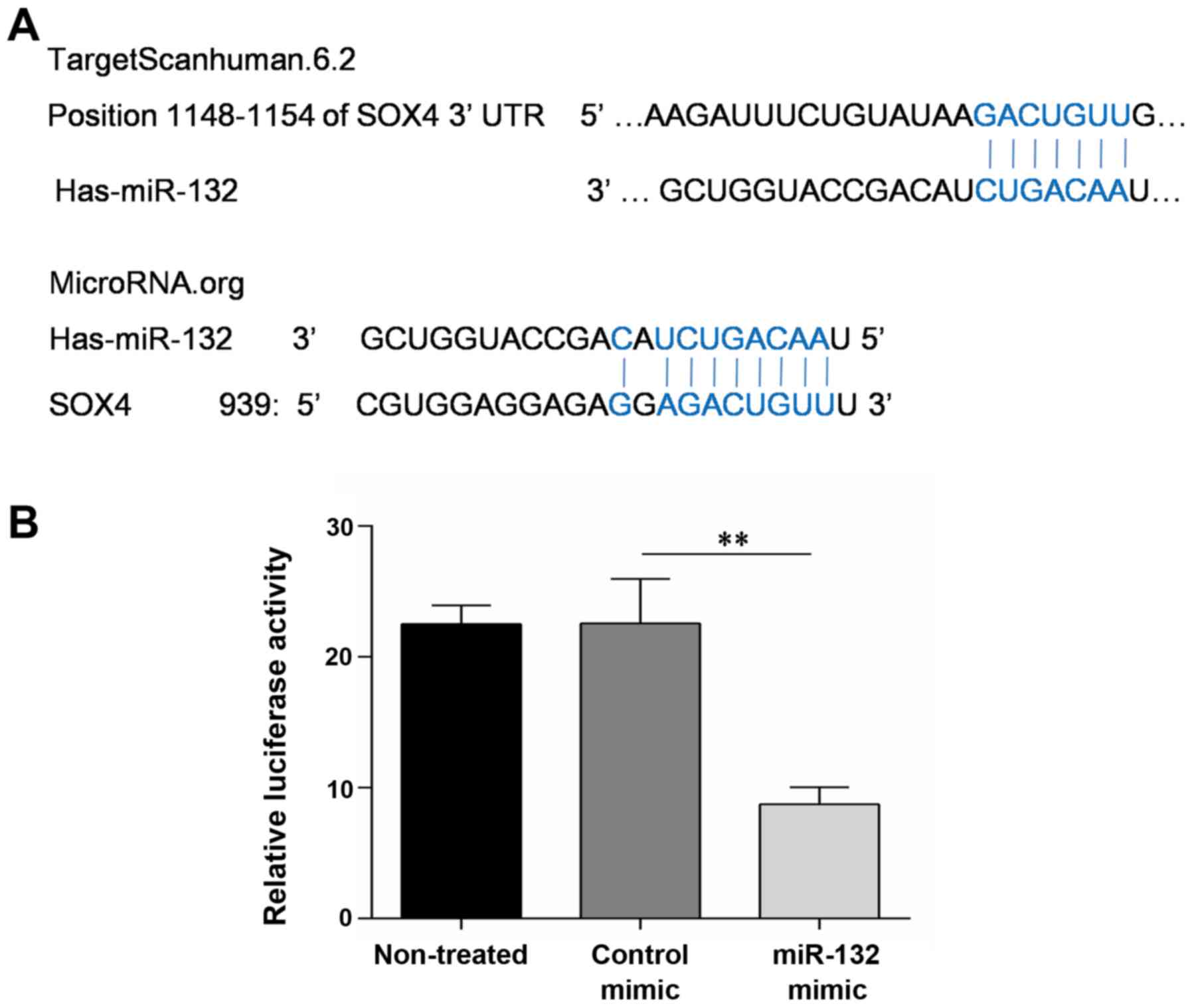Introduction
Liver cancer (LC) is a major cause of morbidity and
mortality. Hepatocellular carcinoma (HCC) is the main histological
subtype of LC, accounting for ~90% of primary LC, and the third
leading cause of cancer-related deaths (1). In 2018, the number of new HCC cases was
841,080, while the number of deaths was 781,631 (1). The early clinical manifestations of LC
are not obvious, and once diagnosed about half are found at an
advanced or terminal stage, while LC also has a poor prognosis and
the 5-year survival rate is only 16% worldwide (2). Approximatey three-quarters of LC cases
are attributed to chronic hepatitis B virus (HBV) and hepatitis C
infections (3). Also, ~50% of
patients with LC have HBV-associated cirrhosis and the morbidity of
LC can be as high as 78% in areas where chronic HBV incidence is
high (4). The risk of LC among
patients with chronic hepatitis (CH) is a 100 times higher compared
with patients without CH and the incidence of HBV-associated
cirrhosis is also higher in patients with CH (5,6). China
has a very high incidence of HBV infection with a high proportion
of new cases every year and has become one of the countries with
the highest incidence of LC in the world (1). Therefore, strategies that may prevent
HBV infection and spread are urgently required. In addition,
understanding the mechanisms of proliferation, apoptosis, invasion,
and migration of LC cells is important for developing better
treatment regimens for patients with LC.
Transcription factor SOX-4 (Sox4) is a 47-kDa
protein and a member of the high-mobility group box transcription
factor family. The DNA-binding domains of Sox4 are as follows: i)
DNA-binding transcription factor activity, RNA polymerase
II-specific; ii) protein heterodimerization activity; and iii)
transcription regulatory region sequence-specific DNA binding
(7). The Sox4 protein, with a
single-box, binds with high sequence specificity to variants of the
DNA sequence (A/T)(A/T)CAAAG resulting in deformation of the DNA
molecule to facilitate the binding of other transcription factors
capable of binding the afore mentioned DNA sequence (8). Meta-analysis data reported that Sox4
plays an important role in tumor development (9). Sox4 has been demonstrated to be highly
expressed in human LC samples and to contribute to
hepatocarcinogenesis by inhibiting p53-mediated apoptosis, while
decreased expression of Sox4 could be a useful prognostic marker
for survival after surgical resection, as low expression levels of
Sox4 could significantly inhibit the growth and migration of LC
cells (10). However, the exact
mechanism by which Sox4 regulates LC development remains
unclear.
MicroRNAs (miRs) are endogenous non-coding RNA
molecules of ~22 nucleotides in length, that function as important
regulators of gene expression by binding to the 3′ untranslated
region (UTR) of specific mRNA molecules (11). Available evidence indicates that
dysregulation of miRs can contribute to tumor progression and
metastasis (12,13). Human miR-132, one of the miRs that
can potentially regulate the expression of various tumor suppressor
genes, including p53, is located on human chromosome 17 (14,15). The
expression of miR-132 in LC, osteosarcoma and colorectal cancer
tissue has been demonstrated to be lower compared with normal
tissue (14–16). In the present study, bioinformatics
analysis predicted Sox4 as a potential target gene of miR-132 and
it was hypothesized that over expression of miR-132 markedly
inhibited cancer cell growth, invasion and migration as well as
promoted cell apoptosis by targeting Sox4.
Materials and methods
Cell lines and culture
Human LC cell lines HepG2, Huh7 and HccLM3 were
obtained from Shanghai Chinese Academy of Sciences. The cells were
cultured in Eagle's Minimum Essential Medium (EMEM; Thermo Fisher
Scientific Inc.) containing 10% FBS (Thermo Fisher Scientific,
Inc.), 1% penicillin and streptomycin solution at 37°C in an
incubator with a humidified atmosphere and 5% CO2.
Transient transfection for HepG2
cells
miR-132 mimic (5′-ACCGUGGCUUUCGAUUGUUACU-3′),
miR-negative control of the mimic (5′-CAGGUAAUCAACGCGGAGGUCA-3′),
miR-132 inhibitor (5′-AGUAACAAUCGAAAGCCACGGU-3′) and miR-negative
control of the inhibitor (5′-CGUGGUGCUCGUGAAGGGUCGG-3′) were
synthesized and purified by Suzhou GenePharma Co., Ltd. All miRs
above were transfected at a final concentration of 50 nmol/l using
Lipofectamine® 2000 reagent (Thermo Fisher Scientific
Inc.) following the manufacturer's protocols. The group with
untreated cells was defined as control group. Total RNA and protein
were extracted 48 h after transfection.
Reverse transcription-quantitative
(RT-q) PCR
Total RNA including miRs was isolated from different
LC cell lines using TRIzol® reagent (Thermo Fisher
Scientific, Inc) following the manufacturer's protocol. By using a
Prime Script reverse-transcribed Reagent Kit with gDNA Eraser (cat.
no. RR047A, Takara Bio, Inc.), total RNA was reverse-transcribed
into cDNA. Gene expression levels were determined via real-time PCR
using the commercial kit (SYBR Premix Ex Taq™ II with Tli RNaseH)
(cat. no. RR820A, Takara Bio, Inc.,) in an ABI PRISM 7500 system
(Thermo Fisher Scientific, Inc.). Thermo cycling conditions were as
follows: 95°C For 5 min; 40 cycles at 95°C for 15 sec; 56°C for 30
sec; and 72°C for 15 sec with a final extension at 72°C for 7 min.
The relative quantification value for each gene was calculated by
the 2−ΔΔCq method (17)
using U6 small nuclear RNA as an internal reference gene. The
following human-specific primers were used: β-actin forward,
5′-AGCGAGCATCCCCCAAAGTT-3′ and reverse, 5′-GGGCACGAAGGCTCATCATT-3;
Sox4, forward, 5′-CAGCAAACCAACAATGCCGA-3′ and reverse,
5′-GATCTGCGACCACACCATG-3′; hsa-miR-132-3p forward,
5′-TGCGCTAACAGTCTACAGCCA-3′ and loop primer,
5′-GTCGTATCCAGTGCAGGGTCCGAGGTATTCGCACTGGATACGACCGACCATG-3′; U6
forward, 5′-CGCTTCGGCAGCACATATAC-3′ and reverse,
5′-AAATATGGAACGCTTCACGA-3′; miRNA antisense strand, the Universal
reverse primer, 5′-CCAGTGCAGGGTCCGAGGTATT-3′. All experiments were
performed in triplicate.
Cell proliferation assay
To explore the effect of miR-132-3p on the
proliferation of HepG2 cells, 3×103 cells were seeded in
a 96-well plate and allowed to grow overnight. The cells were then
transfected with miRs or control sequences for 48 h. The purple
formazan was dissolved using DMSO. MTT cell proliferation assay was
performed at 24, 48 and 72 h at a wavelength of 568 nm. Experiments
were performed in triplicate.
Flow cytometry for apoptosis
analysis
HepG2 cells were transfected with cmiRs for 48 h.
Transfected cells were harvested, washed twice in PBS and then
stained with Annexin V-allophycocyanin (APC) and 7-aminoactinomycin
D (7-AAD) using the Annexin V-APC/7-AAD detection kit (Nanjing
KeyGen Biotech Co., Ltd.) following the manufacturer's protocols.
The apoptotic cells were positively stained by Annexin V. Each
sample was analyzed using a FACSCalibur (BD Biosciences) with Cell
Quest Pro software (version 5.1). All experiments were performed in
triplicate.
Transwell invasion assay
To determine cell invasion, the Transwell Matrigel
invasion assay was conducted using Transwell chambers precoated
with Matrigel at 37°C for 5 h (BD Biosciences), following the
manufacturer's instructions. Briefly, 2×104 HepG2 cells
transfected with miRs were suspended in 150 µl of EMEM without
serum and seeded on the upper chamber. EMEM (600 µl) containing 10%
FBS was added to the lower chamber. After 24 h incubation at 37°C
in a 5% CO2 incubator, cells that remained in the upper
chamber were removed with cotton swabs and the penetrating cells
were fixed in methanol, and then stained with 0.1% crystal violet
for 20 min at room temperature. Cell invasion was quantified by
counting cells on the lower surface by phase contrast microscopy
using an Olympus IX51 microscope (Olympus Corporation).
Quantitative analysis of invasion SPSS 17.0 software (SPSS,
Inc.)
Cell wound healing assay
Migratory ability of LC cells was determined using
the cell wound healing assay. HepG2 cells were plated into six-well
plates without antibiotics. Then, cells were transfected with
miR-132 mimic, mimic control, miR-132 inhibitor and inhibitor
control. After 48 h, transfected cells were digested with 0.25%
pancreatin and 5×105 cells were inoculated into six-well
plates so that they could form a confluent monolayer by the next
day. A 200 µl pipette head perpendicular to the back of the plates
was used to scratch a line, making sure that each well had at least
5 lines. Then, the cells were washed 3 times with PBS and cultured
in serum-free medium at 37°C in an incubator with 5%
CO2. After 24 h, the cells were visualized and images
were captured under an Olympus IX51 phase-contrast inverted
microscope (Olympus Corporation). The width of cell wound closure
was measured at 0 and 24 h of the experiment. All experiments were
performed in triplicate.
Western blot analysis
For protein extraction, HepG2 cells were washed
twice in cold PBS and then lysed in RIPA lysis buffer (Beyotime
Institute of Biotechnology) containing a protease inhibitor
cocktail (Merck KGaA). The protein concentration of cell lysates
was quantified using abicinchoninic acid kit (Beyotime Institute of
Biotechnology) and 40 µg of each of protein extract were separated
by 10% SDS-PAGE, and then transferred to a PVDF membrane. The
membranes were blocked with 5% skimmed milk diluted with
Tris-buffered saline Tween-20 at room temperature for 2 h and
incubated overnight at 4°C with rabbit anti-Sox4 antibody (1:500;
Boster Biotechnology; cat. no. pb0654) and rabbit anti-GAPDH
antibody (1:1,000; cat. no. ab9485; Abcam). The membranes were then
incubated with secondary antibody (1:1,000; cat. no. A0277;
Beyotime Institute of Biotechnology) for 2 h at room temperature.
The protein bands were visualized using ECL plus reagents (Thermo
Fisher Scientific, Inc.). The densitometry of the western blot
protein bands was measured using the BandScan version 5.0 software
(Glyko Biomedical, Ltd). Each sample was analyzed in
triplicate.
Vector construction
The Psi-Check-Sox4 full length 3′UTR plasmid
(Addgene Plasmid #26989) was digested with the NotI and
XhoI enzymes to obtain the full-length 3′UTR of Sox4. The
recombinant vector was termed as pYr-MirTarget (Biovector Lab,
Inc.). All the constructs were verified by sequencing.
Dual-luciferase reporter assay
HepG2 cells (2×105/well) were seeded in
12-well plates. The next day cells were co-transfected with 1 µg
pYr-MirTarget-Sox4-3′UTR reporter plasmid, 50 nmol/l of miR132-3p
mimic or mimic control using Lipofectamine 2000. Then, 24 h after
transfection, both Firefly and Renilla luciferase activities
were quantified using the dual luciferase reporter system (Beyotime
Institute of Biotechnology) according to the manufacturer's
instructions. The relative luciferase unit (Renilla
luciferase/Firefly luciferase) was calculated to determine the
activation of the target gene. All experiments were performed at
least twice.
Bioinformatic analysis
To determinewhether Sox4is a direct target of
miR-132-3p, two bioinformatic software programs were used,
TargetScan.human6.2 (targetscan.org/vert_61/) and microRNA.org August 2010 release (microrna.org/microrna/home.do).
Statistical analysis
Statistical analysis was performed using the SPSS
17.0 software (SPSS, Inc.). The data were presented as the mean ±
standard deviation. One-way analysis of variance followed by
Tukey's or Bonferroni's post hoc test was used for multiple
comparisons between the groups. P<0.05 was considered to
indicate a statistically significant difference.
Results
Expression of miR-132-3p is
downregulated in human LC cell lines
First, the basal expression of miR-132-3p was
determined by RT-qPCR in three liver cancer cell lines (HepG2, Huh7
and HccLM3). The results demonstrated significantly reduced
expression of miR-132-3p in HepG2 and Huh7cell lines compared with
the HccLM3 cell line (Fig. 1). Among
these 3 cell lines, HepG2 was chosen for further experiments due to
its common usage.
An inverse association between the
expression of miR-132-3p and Sox4 in HepG2 cells
As presented in Fig.
2, the level of miR-132-3p was significantly increased
following transfection with miR-132-3p mimics compared with the
mimics control group confirming the successful over expression of
miR-132-3p in HepG2 cells. By contrast, transfection of HepG2 cells
with the miR-132-3p inhibitor decreased the expression level of
miR-132-3p (Fig. 2A). In addition,
the mRNA levels of Sox4 were measured in HepG2 cells as describe
above. Sox4 mRNA expression was decreased in cells overexpressing
miR-132-3p, whereas Sox4 mRNA expression levels were increased in
cells under expressing miR-132-3p, compared with the respective
control groups (Fig. 2B). Protein
expression levels of Sox4 were measured in the control, mimic and
inhibitor groups by western blotting. Similar results to those for
Sox4 mRNA expression levels were obtained (Fig. 2C and D).
miR-132-3p inhibitscell proliferation
and inducesapoptosis in HepG2 cells
After confirming the expression of miR-132-3p in
HepG2 cells, the role of miR-132-3p in proliferation and apoptosis
of HepG2 cells was investigated. Cell proliferation measured using
the MTT assay revealedthat overexpression of miR-132-3p
significantly inhibited the proliferation of HepG2 cells, whereas
decreased expression of miR-132-3p promoted the proliferation of
HepG2 cells at time points 48 and 72 h (Fig. 3A). To determine if proliferation was
inhibited due to cell apoptosis, apoptosis in HepG2 cells
transfected with miR-132-3p mimics or miR-132-3p inhibitor was also
measured. Flow cytometry analysis revealed that the number of
apoptotic HepG2 cells was significantly higher in cells transfected
with miR-132-3p and was significantly lower in cells transfected
with the miR-132-3p inhibitor, compared with their respective
controls (Fig. 3B and C), thus
confirming that miR-132-3p regulated the proliferation and
apoptosis of HepG2 cells.
miR-132-3p inhibits invasion and
migration of HepG2 cells
After transfection for 48 h, the effects of miR-132
on invasion in HepG2 cells were evaluated using the Transwell
invasion chamber assay. The number of invading HepG2 cells was
significantly reduced in cells transfected with miR-132-3p mimics
compared with those transfected with mimic control (Fig. 4A and B). By contrast, the number of
invading cells was significantly increased in HepG2cells
transfected with the miR-132-3p inhibitor, indicating that
miR-132-3p inhibited invasion in HepG2 cells (Fig. 4A and B). The wound healing assay
results demonstrated that the percent wound closure in the
miR-132-3p mimics group was significantly reduced, whereas it was
significantly increased in the miR-132-3p inhibitor group compared
with the inhibitor control group (Fig.
4C and D). Taken together, the results indicated that
miR-132-3p inhibited the migration of HepG2 cells.
Sox4 is a direct target of miR-132-3p
in LC cells
The bioinformatic analysis indicated that the
Sox43′UTR harbors one conserved binding site (TargetScan.human) and
two targets of miR-132-3p (microRNA.org)
(Fig. 5A). These sites were at least
partially complementary to a motif that is found in the seed region
of the miR-132-3p. To confirm thatSox4isa direct target of
miR-132-3p, the 3′UTR was cloned to the downstream of the wild type
luciferase stop codon. The results revealed that overexpression of
miR-132-3p significantly inhibited the luciferase activity of the
pUC57-Sox4-3′UTR (Fig. 5B).
Together, the results of the bioinformatics analysis and luciferase
reporter assay suggested that Sox4 was a direct target of
miR-132-3p in LC cells.
Discussion
Emerging evidence suggests that miR expression is
dysregulated in human malignancies including LC (18). Dysregulated miRs affect the hallmarks
of cancer through the regulation of tumor cell proliferation,
apoptosis and other important pathological processes by targeting
multiple genes and signaling pathways in LC (18). Among the miRs, miR-132-3pexpression
was demonstrated to be more frequently downregulated in
HBV-associated LC tissues (19).
Additionally, miR-132 was found to be downregulated in LC compared
with paracarcinoma and normal liver tissue (19,20). In
the present study it was further confirmed that miR-132-3p
expression was significantly reduced in HepG2 compared with HccLM3
cells. The mechanism underlying this decreased expression is
believed to be mediated through the HBV X protein (HBx)-induced
hypermethylation of the promoter of miR-132, which was previously
demonstrated to be more prevalent in HBx-expressing HepG2 cells
(21). Low expression of miR-132 has
been observed in other types of human cancer, including colorectal,
lung, cervical, breast cancers and glioma (22–25). By
contrast, high miR-132 expression has been reported in gastric
cancer (26). The mean level of
miR-132 in LC tissues was significantly lower than that found in
matched tumor-adjacent tissues and its expression was negatively
associated with tumor differentiation and the TNM stage, which is a
cancer staging notation system that describes the stage of a cancer
which originates from a solid tumor with alphanumeric codes and
lymph node metastasis (21).
Additionally in the aforementioned study, miR-132 inhibited tumor
growth, volume and weight (20).
However the precise role and mechanism through which miR-132 exerts
its effect on LC was unclear. In the present study, the biological
functions and mechanism by which miR-132-3p regulates LC were
elucidated. Furthermore, to the best of the authors' knowledge, the
current study was the first to demonstrate that Sox4 was a novel
target of miR-132-3p in LC.
In the present study, miR-132-3p mimics and
anmiR-132-3p inhibitor were used to modulate the expression of
miR-132-3p in HepG2 cells. The results of the MTT assays
demonstrated that overexpression of miR-132-3p inhibited the
proliferation of HepG2 cells. Consistent with the results of the
current study, Liu et al (20) reported that ectopic expression of
miR-132 inhibited cell proliferation, colony formation, migration
and invasion, as well as induced apoptosis in HepG2 cells in
vitro. Liu et al also demonstrated that miR-132
inhibited LC growth and decreased cancer volume and weight in
vivo. In addition, proliferation and colony formation of LC
cells were revealed to be suppressed by the miR-132-mediated
inhibition of the Akt-signaling pathway in miR-132-transfected
cells (26). The present study
demonstrated that high levels of miR-132 significantly induced
apoptosis of HepG2 cells. However, cell proliferation was promoted
and cell apoptosis was inhibited in HepG2 cells transfected with
the miR-132-3p inhibitor compared with the inhibitor control group.
Moreover, invasion and migration of HepG2 cells were inhibited by
the overexpression of miR-132-3p, which was reversed by miR-132-3p
inhibitor transfection. The molecular mechanism underlying this
beneficial effect of miR-132-3p was investigated by undertaking the
identification and validation of a potential target of
miR-132-3p.
Sox4 expression was reported to be increased in
63.8% of human HCC tissue samples and the increased expression of
Sox4 promoted HCC development (10).
Since Sox4 has been demonstrated to be overexpressed in HCC and to
contribute to hepatocarcinogenesis, the present study sought to
determine whether Sox4 was a direct target of miR-132-3p in LC
cells. This was first determined through bioinformatic analysis
using two independent bioinformatic software tools. Furthermore,
the present study determined that the expression of Sox4 mRNA and
protein in HepG2 cells was inversely proportional to the level of
miR-132-3p. These findings are consistent with previous findings in
osteosarcoma and lung cancer cells indicating that Sox4 is a target
of miR-132-3p (27,28). Moreover, it has been reported that
miR-132-3p inhibited cell growth and metastasis in osteosarcoma
cells by downregulating Sox4, and knockdown of Sox4 promoted
miR-132-mediated cell growth and metastasis in osteosarcoma cells
(27). Similar to the results of the
present study, the expression of miR-132 in non-small cell lung
carcinoma cells was decreased, and overexpression of miR-132
inhibited cell invasion and migration by targeting SOX4 (28).
Zheng et al (29) reported that overexpression of miR-132
in colorectal cancer cells inhibited cell invasion and migration by
targeting the zinc finger E-box binding homeobox 2 gene. Another
report indicated that miR-132 regulated apoptosis of glioma cells
by blocking the sterol regulatory element-binding transcription
factor 1 metabolic pathway related to Sirtuin 1 (30). Studies have also reported that
overexpression of Sox4 was closely associated with tumor
progression and metastasis (31,32).
Sox4 maybe a crucial oncogene affecting tumor progression and
metastasis in HCC and lung cancer (10,33).
Overexpression of Sox4 has also been detected in other types of
solid tumors including prostate, breast, bladder and lung cancer
(7,34,35).
Downregulation of the expression of Sox4 inhibited cell
proliferation, metastasis and induced apoptosis in lung cancer
cells (33).
Since one miR can target multiple genes, it was
important to determine whether miR-132-3p targeted other genes
besides Sox4 in the same and in different signaling pathways. In
this respect, proliferation and colony formation of LC cells were
suppressed through the miR-132-mediated inhibition of the
AKT-signaling pathway in miR-132-transfected cells (26). Furthermore, miR-132 expression was
inversely associated with PIK3R3 mRNA expression levels in clinical
HCC tissue samples (20).
Yes-associated protein 1 is also a potential target of miR-132
(19). The involvement of these
targets in a similar signaling pathway in miR-132-3p-mediated
regulation of LC warrants further investigation.
Taking the findings of the present study together,
it can be hypothesized that miR-132-3p maybe a potential
antioncogene in liver cancer. In addition, the present study
demonstrates that miR-132-3p serves an important role in regulating
proliferation, apoptosis, invasion and migration in LC cells.
Further studies are required to evaluate the effects of miR-132-3p
in animal models of LC as well as in human LC tissue specimens,
blood and plasma samples. The present study provides new insights
into the molecular mechanisms mediating the development of human
LC. The regulation of miR-132-3p-targeted genes in patients with LC
may be an efficacious therapeutic strategy. Additionally, it may
enable the screening of early stage LC by determining the level of
miR-132-3p in human blood.
Acknowledgements
Not applicable.
Funding
This study was supported by grants from the National
Natural Science Foundation of China (grant. no. 81760115), Chinese
Foundation for Hepatitis prevention and Control-TianQing Liver
Disease Research Fund (grant. no. TQGB20170052).
Availability of data and materials
All data generated or analyzed during this study are
included in this published article.
Authors' contributions
JH, DL, TX and SG performed the experiments. XW and
YW analyzed the data. JH, JW and NC contributions to conception and
design, and drafting the manuscript or revising it critically for
important intellectual content. All authors read and approved the
final manuscript.
Ethics approval and consent to
participate
Not applicable.
Patient consent for publication
Not applicable.
Competing interests
The authors declare that they have no competing
interests.
References
|
1
|
Bray F, Ferlay J, Soerjomataram I, Siegel
RL, Torre LA and Jemal A: Global cancer statistics 2018: GLOBOCAN
estimates of incidence and mortality worldwide for 36 cancers in
185 countries. CA Cancer J Clin. 68:394–424. 2018. View Article : Google Scholar : PubMed/NCBI
|
|
2
|
Siegel R, Naishadham D and Jemal A: Cancer
statistics, 2013. CA Cancer J Clin. 63:11–30. 2013. View Article : Google Scholar : PubMed/NCBI
|
|
3
|
Yang JD and Roberts LR: Hepatocellular
carcinoma: A global view. Nat Rev Gastroenterol Hepatol. 7:448–458.
2010. View Article : Google Scholar : PubMed/NCBI
|
|
4
|
Forner A, Llovet JM and Bruix J:
Hepatocellular carcinoma. Lancet. 379:1245–1255. 2012. View Article : Google Scholar : PubMed/NCBI
|
|
5
|
Sherman M: Hepatocellular carcinoma:
Epidemiology, surveillance, and diagnosis. Semin Liver Dis.
30:3–16. 2010. View Article : Google Scholar : PubMed/NCBI
|
|
6
|
Beasley RP, Hwang LY, Lin CC and Chien CS:
Hepatocellular carcinoma and hepatitis B virus. A prospective study
of 22 707 men in Taiwan. Lancet. 2:1129–1133. 1981. View Article : Google Scholar : PubMed/NCBI
|
|
7
|
Grimm D, Bauer J, Wise P, Krüger M,
Simonsen U, Wehland M, Infanger M and Corydon TJ: The role of SOX
family members in solid tumours and metastasis. Semin Cancer Biol.
Mar 23–2019.(Epub ahead of print). doi:
10.1016/j.semcancer.2019.03.004. View Article : Google Scholar : PubMed/NCBI
|
|
8
|
van Houte LP, Chuprina VP, van der
Wetering M, Boelens R, Kaptein R and Clevers H: Solution structure
of the sequence-specific HMG box of the lymphocyte transcriptional
activator Sox-4. J Biol Chem. 270:30516–30524. 1995. View Article : Google Scholar : PubMed/NCBI
|
|
9
|
Rhodes DR, Yu J, Shanker K, Deshpande N,
Varambally R, Ghosh D, Barrette T, Pandey A and Chinnaiyan AM:
Large-scale meta-analysis of cancer microarray data identifies
common transcriptional profiles of neoplastic transformation and
progression. Proc Natl Acad Sci USA. 101:9309–9314. 2004.
View Article : Google Scholar : PubMed/NCBI
|
|
10
|
Hur W, Rhim H, Jung CK, Kim JD, Bae SH,
Jang JW, Yang JM, Oh ST, Kim DG, Wang HJ, et al: SOX4
overexpression regulates the p53-mediated apoptosis in
hepatocellular carcinoma: Clinical implication and functional
analysis in vitro. Carcinogenesis. 31:1298–1307. 2010. View Article : Google Scholar : PubMed/NCBI
|
|
11
|
Treiber T, Treiber N and Meister G:
Regulation of microRNA biogenesis and function. Thromb Haemost.
107:605–610. 2012. View Article : Google Scholar : PubMed/NCBI
|
|
12
|
Jafri MA, Al-Qahtani MH and Shay JW: Role
of miRNAs in human cancer metastasis: Implications for therapeutic
intervention. Semin Cancer Biol. 44:117–131. 2017. View Article : Google Scholar : PubMed/NCBI
|
|
13
|
Kogure A, Kosaka N and Ochiya T:
Cross-talk between cancer cells and their neighbors via miRNA in
extracellular vesicles: An emerging player in cancer metastasis. J
Biomed Sci. 26:72019. View Article : Google Scholar : PubMed/NCBI
|
|
14
|
Zhao DW, Hou YS, Sun FB, Han B and Li SJ:
Effects of miR-132 on proliferation and apoptosis of pancreatic
cancer cells via Hedgehog signaling pathway. Eur Rev Med Pharmacol
Sci. 23:1978–1985. 2019.PubMed/NCBI
|
|
15
|
Chen Y, Zhu H, Wang Y, Song Y, Zhang P,
Wang Z, Gao J, Li Z and Du Y: MicroRNA-132 plays an independent
prognostic role in pancreatic ductal adenocarcinoma and acts as a
tumor suppressor. Technol Cancer Res Treat.
18:15330338188243142019. View Article : Google Scholar : PubMed/NCBI
|
|
16
|
Liu Y and Zhang M: MiR-132 regulates
adriamycin resistance in colorectal cancer cells through targeting
extracellular signal-regulated kinase 1. Cancer Biother Radiopharm.
4:398–404. 2019. View Article : Google Scholar
|
|
17
|
Livak KJ and Schmittgen TD: Analysis of
relative gene expression data using real-time quantitative PCR and
the 2(-Delta Delta C(T)) method. Methods. 25:402–408. 2001.
View Article : Google Scholar : PubMed/NCBI
|
|
18
|
Song K, Han C, Zhang J, Lu D, Dash S,
Feitelson M, Lim K and Wu T: Epigenetic regulation of MicroRNA-122
by peroxisome proliferator activated receptor-gamma and hepatitis b
virus X protein in hepatocellular carcinoma cells. Hepatology.
58:1681–1692. 2013. View Article : Google Scholar : PubMed/NCBI
|
|
19
|
Lei CJ, Li L, Gao X, Zhang J, Pan QY, Long
HC, Chen CZ, Ren DF and Zheng G: Hsa-miR-132 inhibits proliferation
of hepatic carcinoma cells by targeting YAP. Cell Biochem Funct.
33:326–333. 2015. View
Article : Google Scholar : PubMed/NCBI
|
|
20
|
Liu K, Li X, Cao Y, Ge Y, Wang J and Shi
B: MiR-132 inhibits cell proliferation, invasion and migration of
hepatocellular carcinoma by targeting PIK3R3. Int J Oncol.
47:1585–1593. 2015. View Article : Google Scholar : PubMed/NCBI
|
|
21
|
Wei X, Tan C, Tang C, Ren G, Xiang T, Qiu
Z, Liu R and Wu Z: Epigenetic repression of miR-132 expression by
the hepatitis B virus × protein in hepatitis B virus-related
hepatocellular carcinoma. Cell Signal. 25:1037–1043. 2013.
View Article : Google Scholar : PubMed/NCBI
|
|
22
|
Kara M, Yumrutas O, Ozcan O, Celik OI,
Bozgeyik E, Bozgeyik I and Tasdemir S: Differential expressions of
cancer-associated genes and their regulatory miRNAs in colorectal
carcinoma. Gene. 567:81–86. 2015. View Article : Google Scholar : PubMed/NCBI
|
|
23
|
Wang H, Li XT, Wu C, Wu ZW, Li YY, Yang
TQ, Chen GL, Xie XS, Huang YL, Du ZW and Zhou YX: MiR-132 can
inhibit glioma cells invasion and migration by target MMP16 in
vitro. Onco Targets Ther. 8:3211–3218. 2015.PubMed/NCBI
|
|
24
|
Zhang H, Liu A, Feng X, Tian L, Bo W, Wang
H and Hu Y: MiR-132 promotes the proliferation, invasion and
migration of human pancreatic carcinoma by inhibition of the tumor
suppressor gene PTEN. Prog Biophys Mol Biol. 148:65–72. 2017.
View Article : Google Scholar : PubMed/NCBI
|
|
25
|
Zhou K, Zhang C, Yao H, Zhang X, Zhou Y,
Che Y and Huang Y: Knockdown of long non-coding RNA NEAT1 inhibits
glioma cell migration and invasion via modulation of SOX2 targeted
by miR-132. Mol Cancer. 17:1052018. View Article : Google Scholar : PubMed/NCBI
|
|
26
|
Wu WK, Lee CW, Cho CH, Fan D, Wu K, Yu J
and Sung JJ: MicroRNA dysregulation in gastric cancer: A new player
enters the game. Oncogene. 29:5761–5771. 2010. View Article : Google Scholar : PubMed/NCBI
|
|
27
|
Liu Y, Li Y, Liu J, Wu Y and Zhu Q:
MicroRNA-132 inhibits cell growth and metastasis in osteosarcoma
cell lines possibly by targeting Sox4. Int J Oncol. 47:1672–1684.
2015. View Article : Google Scholar : PubMed/NCBI
|
|
28
|
Li Y, Zu L, Wang Y, Wang M, Chen P and
Zhou Q: MiR-132 inhibits lung cancer cell migration and invasion by
targeting SOX4. J Thorac Dis. 7:1563–1569. 2015.PubMed/NCBI
|
|
29
|
Zheng YB, Luo HP, Shi Q, Hao ZN, Ding Y,
Wang QS, Li SB, Xiao GC and Tong SL: miR-132 inhibits colorectal
cancer invasion and metastasis via directly targeting ZEB2. World J
Gastroenterol. 20:6515–6522. 2014. View Article : Google Scholar : PubMed/NCBI
|
|
30
|
Li Y, Zhang J, He J, Zhou W, Xiang G and
Xu R: MicroRNA-132 cause apoptosis of glioma cells through blockade
of the SREBP-1c metabolic pathway related to SIRT1. Biomed
Pharmacother. 78:177–184. 2016. View Article : Google Scholar : PubMed/NCBI
|
|
31
|
Wang L, Zhang J, Yang X, Chang YW, Qi M,
Zhou Z, Zhang J and Han B: SOX4 is associated with poor prognosis
in prostate cancer and promotes epithelial-mesenchymal transition
in vitro. Prostate Cancer Prostatic Dis. 16:301–307. 2013.
View Article : Google Scholar : PubMed/NCBI
|
|
32
|
Zhang H, Alberich-Jorda M, Amabile G, Yang
H, Staber PB, Di Ruscio A, Welner RS, Ebralidze A, Zhang J,
Levantini E, et al: Sox4 is a key oncogenic target in C/EBPα mutant
acute myeloid leukemia. Cancer Cell. 24:575–588. 2013. View Article : Google Scholar : PubMed/NCBI
|
|
33
|
Zhou Y, Wang X, Huang Y, Chen Y, Zhao G,
Yao Q, Jin C, Huang Y, Liu X and Li G: Down-regulated SOX4
expression suppresses cell proliferation, metastasis and induces
apoptosis in Xuanwei female lung cancer patients. J Cell Biochem.
116:1007–1018. 2015. View Article : Google Scholar : PubMed/NCBI
|
|
34
|
Zhang J, Liang Q, Lei Y, Yao M, Li L, Gao
X, Feng J, Zhang Y, Gao H, Liu DX, et al: SOX4 induces
epithelial-mesenchymal transition and contributes to breast cancer
progression. Cancer Res. 72:4597–4608. 2012. View Article : Google Scholar : PubMed/NCBI
|
|
35
|
Castillo SD, Matheu A, Mariani N,
Carretero J, Lopez-Rios F, Lovell-Badge R and Sanchez-Cespedes M:
Novel transcriptional targets of the SRY-HMG box transcription
factor SOX4 link its expression to the development of small cell
lung cancer. Cancer Res. 72:176–186. 2012. View Article : Google Scholar : PubMed/NCBI
|















